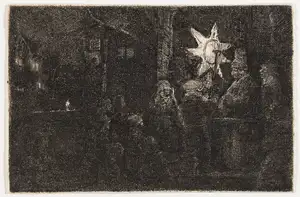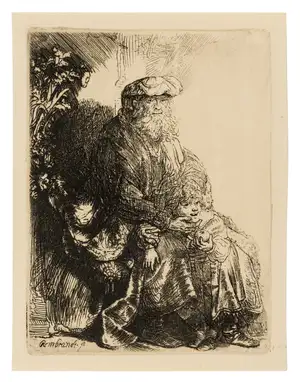Description
Albrecht Dürer (1471-1528)
Saint Eustace
Engraving, circa 1501, but a Meder g (of k) impression, with very faint horizontal scratch to the left of the tower and the two strokes on the back of the dog still partially visible, on laid paper affixed onto old supports, sheet 350 x 255 mm (13 3/4 x 10 in), trimmed within the borderline with approx. 5-6 mm of image missing from the top edge, extensive areas of small loss within the image and to edges, very fine pounce marks to the recumbent dog from an artist transferring the image, splitting and rubbing to sheet, with signs of silverfish damage to back of the horse and scattered elsewhere, browning and surface dirt to sheet (framed)
Literature:
S.M.S. 32
⁂ The pouncing found on the dog illustrates the Renaissance transfer process that Dürer was said to use himself, where an artist uses pin pricks and charcoal to transfer images from one surface to the next. The artist who once owned the present engraving presumably wished to emulate the beauty of the greyhounds; an echo of Vasari's famous description of the the engraving as ''amazing, and particularly for the beauty of some dogs in various attitudes, which could not be more perfect".
Description
Albrecht Dürer (1471-1528)
Saint Eustace
Engraving, circa 1501, but a Meder g (of k) impression, with very faint horizontal scratch to the left of the tower and the two strokes on the back of the dog still partially visible, on laid paper affixed onto old supports, sheet 350 x 255 mm (13 3/4 x 10 in), trimmed within the borderline with approx. 5-6 mm of image missing from the top edge, extensive areas of small loss within the image and to edges, very fine pounce marks to the recumbent dog from an artist transferring the image, splitting and rubbing to sheet, with signs of silverfish damage to back of the horse and scattered elsewhere, browning and surface dirt to sheet (framed)
Literature:
S.M.S. 32
⁂ The pouncing found on the dog illustrates the Renaissance transfer process that Dürer was said to use himself, where an artist uses pin pricks and charcoal to transfer images from one surface to the next. The artist who once owned the present engraving presumably wished to emulate the beauty of the greyhounds; an echo of Vasari's famous description of the the engraving as ''amazing, and particularly for the beauty of some dogs in various attitudes, which could not be more perfect".












